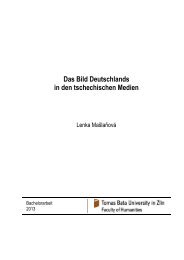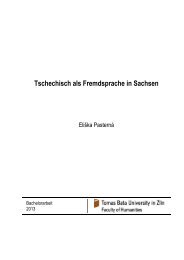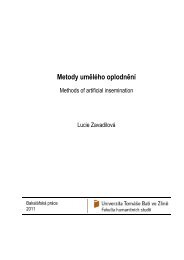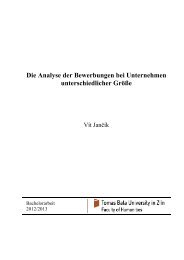The study of using of nanofillers in polyolefinic matrix - DSpace UTB
The study of using of nanofillers in polyolefinic matrix - DSpace UTB
The study of using of nanofillers in polyolefinic matrix - DSpace UTB
You also want an ePaper? Increase the reach of your titles
YUMPU automatically turns print PDFs into web optimized ePapers that Google loves.
Tomas Bata University <strong>in</strong> Zlín, Faculty <strong>of</strong> Technology<br />
<strong>The</strong> central cations <strong>of</strong> octahedrite are Al 3+ , Fe 3+ Fe 2+ , Mg 2+ , Mn 2+ , Ca 2+ or Li + . <strong>The</strong> sign <strong>of</strong><br />
anion A is used due to <strong>of</strong> possibility <strong>of</strong> presence <strong>of</strong> anion <strong>of</strong> octahedrite O, OH, or F <strong>in</strong> sheet<br />
silicates. [30]<br />
a) b)<br />
Fig. 2 <strong>The</strong> chart <strong>of</strong> a) tetrahedrite and b) octahedrite. <strong>The</strong> black po<strong>in</strong>ts represent central cation<br />
3.2. MONTMORILLONITE<br />
and white po<strong>in</strong>ts represent anion. [30]<br />
<strong>The</strong> name <strong>of</strong> montmorillonite is derived from the deposit Montmorillon which is <strong>in</strong> France.<br />
Montmorillonite is clay m<strong>in</strong>eral which is classified <strong>in</strong> class <strong>of</strong> dioctahedral smectite.<br />
Montmorillonite is hydrophilic clay m<strong>in</strong>eral. <strong>The</strong> structure <strong>of</strong> montmorillonite is 2:1 – two<br />
silicon tetrahedral layers and one alum<strong>in</strong>um octahedral layer. Fig. X shows the structure <strong>of</strong><br />
montmorillonite. [30]<br />
Fig. 3 Structure <strong>of</strong> montmorillonite [32]<br />
<strong>The</strong> tetrahedral position <strong>of</strong> montmorillonite have not got any or very low degree <strong>of</strong><br />
substitution <strong>of</strong> Al 3+ for Si 4+ due to the charge <strong>of</strong> 2:1 layer is caused by octahedral substitution.<br />
[30]<br />
~ 13 ~

















